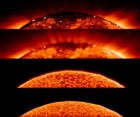Coronal Spectroscopy and Imaging
 The group studies physical processes in the solar chromosphere, transition region and corona, thereby applying both observational techniques and theoretical modelling. The upper solar atmosphere is best observed in the wavelength ranges of the far and extreme ultraviolet and soft X-rays, emissions that are only accessible from space. Our research aims at describing and understanding the fundamental plasma processes at all scales in the upper solar atmosphere and addresses in particular the unsolved problems of coronal heating and solar wind acceleration. We also study atomic radiation processes, ionic excitation and de-excitation, radiation transport and wave-particle interactions.
The group studies physical processes in the solar chromosphere, transition region and corona, thereby applying both observational techniques and theoretical modelling. The upper solar atmosphere is best observed in the wavelength ranges of the far and extreme ultraviolet and soft X-rays, emissions that are only accessible from space. Our research aims at describing and understanding the fundamental plasma processes at all scales in the upper solar atmosphere and addresses in particular the unsolved problems of coronal heating and solar wind acceleration. We also study atomic radiation processes, ionic excitation and de-excitation, radiation transport and wave-particle interactions.
Science objectives
In our research, which is mainly - but not exclusively - based on ultraviolet imaging and spectroscopy techniques, we are concerned with a number of scientific topics and exploit various methods, including
 spectroscopy to study continua and emission lines
spectroscopy to study continua and emission lines- morphology of coronal holes, spicules, sunspots, prominences, filaments, plumes, flares
- coronal heating and energy transport
- plasma flows, jets and transient events; solar wind acceleration
- coronal waves and oscillations
- density and temperature diagnostic, FIP effect, atomic physics
- radiation transport and line profiles
- Sun as a star and stellar spectra, ir/radiance measurements, line identification
Our work is closely connected to solar remote-sensing observations from space, in particular made by the spectrometers and imagers on
 SOHO
(
SOHO
( SUMER,
SUMER,
 CDS,
CDS,
 EIT,
MDI), on
EIT,
MDI), on
 Hinode (SOT, XRT, EIS), on
Hinode (SOT, XRT, EIS), on
 STEREO (EUVI), and on
STEREO (EUVI), and on
 SDO (AIA, HMI).
SDO (AIA, HMI).
New data from instruments on future missions like
 EUI,
EUI,
 SPICE,
SPICE,
 METIS on
METIS on
 Solar Orbiter and like
Solar Orbiter and like
 IRIS
will be accessible to the group and will also be studied by us. Thus we will gradually enlarge and complement the available data archives.
IRIS
will be accessible to the group and will also be studied by us. Thus we will gradually enlarge and complement the available data archives.
![[Top]](/images/icons/top.gif)
The Team
![[Top]](/images/icons/top.gif)
PhD projects
Various PhD and thesis projects in this field of research are offered and supported by the
 Max Planck Research School:
Max Planck Research School:
 The solar transition region: microflares, explosive events and spicules
The solar transition region: microflares, explosive events and spicules
 Downflows in the solar corona
Downflows in the solar corona
 Quiet Sun mini-CMEs
Quiet Sun mini-CMEs
 Diagnostics of the solar corona via vacuum ultraviolet spectroscopy and imaging
Diagnostics of the solar corona via vacuum ultraviolet spectroscopy and imaging
 Chromospheric and coronal magnetic fields
Chromospheric and coronal magnetic fields
 Coronal holes
Coronal holes
 Solar Instrumentation
Solar Instrumentation
![[Top]](/images/icons/top.gif)
Cooperating Groups
In our research we cooperate with various international groups and institutions. Some of them are listed here:
 AIP, Astrophysikalisches Institut Potsdam (Potsdam)
AIP, Astrophysikalisches Institut Potsdam (Potsdam)
 NRL, Naval Research Laboratory (Washington)
NRL, Naval Research Laboratory (Washington)
 RAL, Rutherford Appleton Laboratory (Didcot)
RAL, Rutherford Appleton Laboratory (Didcot)
 MSSL, Mullard Space Science Laboratory (Holmbury)
MSSL, Mullard Space Science Laboratory (Holmbury)
 IAS, Institut d'Astrophysique Spatiale (Paris)
IAS, Institut d'Astrophysique Spatiale (Paris)
 NASA-GSFC, Goddard-Space-Flight-Center (Washington)
NASA-GSFC, Goddard-Space-Flight-Center (Washington)
 KIS, Kiepenheuer-Institut für Sonnenphysik (Freiburg)
KIS, Kiepenheuer-Institut für Sonnenphysik (Freiburg)
PKU-SESS, School of Earth and Space Sciences, Peking University (Beijing)
 LMSAL, Lockheed-Martin Solar and Astrophysics Lab. (Palo Alto)
LMSAL, Lockheed-Martin Solar and Astrophysics Lab. (Palo Alto)
 St. Andrews University, Solar Theory Group (St. Andrews)
St. Andrews University, Solar Theory Group (St. Andrews)
 Arcetri Astrophysical Observatory (Firenze)
Arcetri Astrophysical Observatory (Firenze)
 Armagh Observatory, Solar Physics Group (Armagh, Northern Ireland)
Armagh Observatory, Solar Physics Group (Armagh, Northern Ireland)
 SwRI, Southwest Research Institute (Boulder)
SwRI, Southwest Research Institute (Boulder)
 CSL Centre Spatial de Liège (Liège, Belgium)
CSL Centre Spatial de Liège (Liège, Belgium)
 ROB Royal Observatory of Belgium (Brussels)
ROB Royal Observatory of Belgium (Brussels)
 NAOJ National Astronomical Observatory of Japan (Mitaka, Japan)
NAOJ National Astronomical Observatory of Japan (Mitaka, Japan)
SDU-SSSP, School of Space Science and Physics, Shandong University (Weihai, China)
![[Top]](/images/icons/top.gif)
